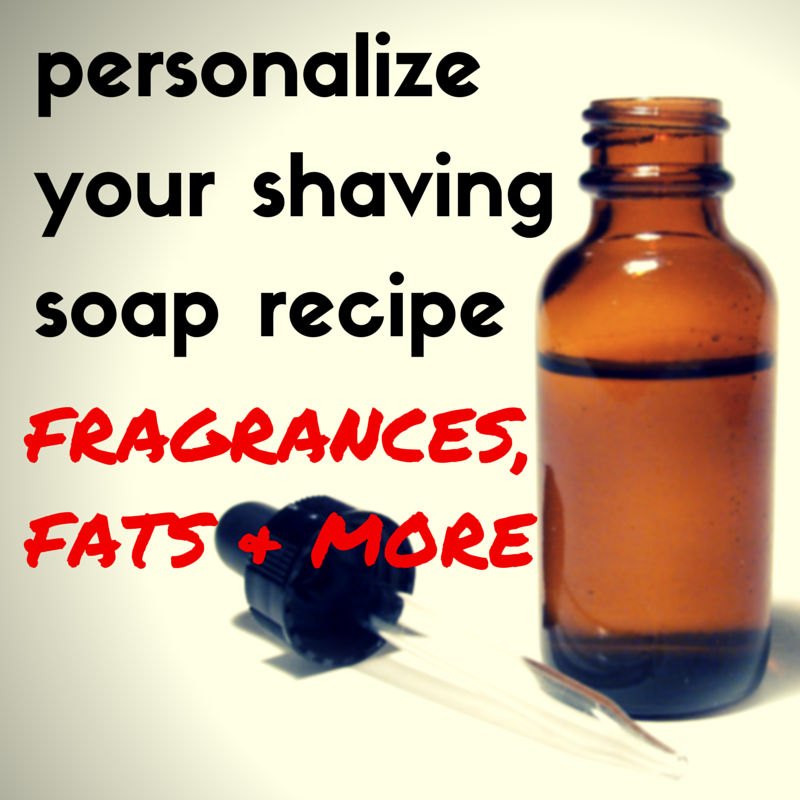So you have a shaving soap recipe that gives you a good shave and a rich, stable lather – but that’s it. For now, it’s unscented and far from extraordinary.
This is part of the process, though. It’s easier to establish a foundation and manipulate one or two things at a time in subsequent batches. When something goes wrong, this limits the number of possible culprits.
Now that we’ve got a solid foundation, it’s time to get a little more creative!
When adapting your recipe from the basic shaving soap recipe post, I recommend you change only one of these things at a time. Feel free to change more than this, but understand that if you experience difficulties, it will be hard to track down a definite cause. Even if everything goes well, it might be hard to figure out the contribution of each tweak to a certain property (such as slip), and you’ll have less information to go on during future experiments.
Fragrance
The first modification many soap makers will make is adding a fragrance. If you’re familiar with shaving soap in general, you’ll know that a refreshing fragrance is almost as important as the actual performance of a soap.
Advocates of Arko soap describe it as ‘lemony’, while detractors claim the scent is closer to ‘janitorial product’. A scent can make or break your end product.

However, don’t forget that fragrance oils and essential oils also bring their own set of challenges to the table:
Flash/evaporation point
Each oil has a specific temperature at which it will simply evaporate. Make sure you know the relevant temperature for your fragrance, and use an accurate thermometer to check the temperature of your soap before you add them.
Trace
Fragrance and essential oils can speed up trace. This isn’t a huge issue in hot process soap making, because you are keeping the soap at a higher temperature than in cold process, and therefore malleable – but it’s still something worth noting, as it can affect your cook times.
Discoloration
Fragrances can change the color of your soap. Usually, this discoloration is only minor. Most shaving soaps are an off-white anyway, so you might not be too concerned about this. If you are, you might want to use a colorant to combat it.
Mystery interactions
Sometimes your fragrance/essential oils don’t play nicely with your chosen oils or other ingredients. This doesn’t happen too often, but it can be completely unpredictable and frustrating.
To add fragrance to your soap, cook it in your crockpot as described in the basic recipe. Then, when it is safely below the evaporation point for your chosen fragrance, add about 1 tsp of fragrance/essential oils per lb of soap. Mix your soap thoroughly to make sure the fragrance is evenly distributed.
If you are mixing multiple oils, you will most likely need to use more of that ~1 tsp for top notes such as citrus, and less for mid/base notes like sandalwood and rosemary. A top note will evaporate quicker than more durable mid and base notes.
For now, I recommend sticking with one to three elements. Keep it simple in the beginning! That way, when you try more sophisticated combinations later, you can find the source of any problems. Anyway, there are plenty of interesting and uncommon scents with just two or three ingredients.
You can find a range of essential oils and fragrance oils on Amazon as well as soap supply stores such as Brambleberry. However, when buying from Amazon, make sure the product is marked as safe for use in skincare or bath products.
Most purchasers of these oils use them for aromatherapy, so it doesn’t matter if an oil irritates the skin. Keep in mind that if you don’t check for this, you may be fine, or your skin may be red and irritated when you actually use your shaving soap.
For Example:
Superfat
Superfats have a great effect on the hydrating and moisturizing properties of a soap. They can also be tailored for certain skin types or conditions, such as acne or dry skin.
Popular superfats in most shaving soaps are shea butter, kokum butter, castor oil, and mango butter. These are definitely a great place to start.
Plus, because you’re making your soap at home, you have a bit more choice than the standard superfats used in most commercial shaving soaps. You might decide to use something more exotic like avocado oil – but I recommend saving these relatively expensive oils for later, when you know they won’t be wasted during a learning experience!
To superfat your soap, just cook the soap as described in the first part of this post. Then, when it has passed a pH test, add in your superfat and mix it through the soap thoroughly.
The amount of fat you add can be tweaked up or down in subsequent batches. For this trial run, I would recommend adding 2-5% of the total weight of your base oils.
So, if you are making 1 lb of soap as per the original recipe, you would add ⅓ oz to ¾ oz (9-22 g) of your chosen superfat(s).
Don’t add too much, because you might end up with a greasy soap. A superfat percentage that is too high will kill your lather, so more is not always better. For this reason, I would recommend starting with around ¼ to ½ oz of fat.
Again, you can add more than one type, but sticking with just one may be a good idea for your first try.
For Example:
- ¼ oz shea butter
- ¼ oz castor oil
- ¼ oz mango butter
Base Oils
Ok, so this makes the recipe a little redundant – but it’s possible that you’d like to swap some or all of the coconut oil and/or stearic acid for something else.
Keep in mind that this will substantially change the properties of your soap, including how much lye you’ll need.
Remember how I said I’d introduce a fantastic online resource for making soap in the last post? This is where Soapcalc comes in.
Soapcalc will take the proportions of different fats in your recipe, and give you a rough idea of the characteristics of the resulting soap. Pretty neat, right?
Plus, it will tell you how much lye you need to completely saponify an amount of oil.
Using and understanding Soapcalc will be the topic of another post – but for now, it’s interesting to play around with for a few minutes and browse the extensive list of fats. (Chicken shaving soap, anyone?)
For Example:
- Exchange the stearic acid and extra glycerin for tallow (which will produce its own glycerin). Check out US Wellness Meats, or ask your butcher – in which case you may have to render your own.
- Exchange 1 oz coconut oil for 1 oz palm oil
Other Additives
Many popular soap makers use additives that may not undergo saponification or change the smell of shaving soap. Instead, they sit inside the soap and contribute other valuable characteristics. These can include slip, moisturization, and other skin-related benefits.
These additives can be as simple as skin-soothing aloe or extra glycerin for slip, or they can be as exotic as silk powder or lanolin (the ‘wool fat’ of the well-known Mitchell’s Wool Fat shaving soap).
Because these ingredients are sometimes expensive, you may wish to perfect your base soap first. Alternatively, you can split your batch, and add some to one half. This way, you can directly compare the difference between soaps.
You may also wish to let your soap cool as much as possible before adding these ingredients. Although some (like lanolin) are waxes or oils and therefore probably heat-resistant, others may be negatively affected by heat.
For Example:
- ¼ oz Aloe extract (reduces irritation)
- 1 tbsp Bentonite clay (provides slip; easier to mix when blended with a superfat first)
- ⅓ oz Lanolin
Lye Ratio
Remember, this recipe uses KOH (potassium hydroxide), and this means it would produce a softer soap. NaOH (sodium hydroxide) could be used in place of the KOH in this recipe.
This would move the recipe closer to a hard variety of shaving soap.
Alternatively, you could use a mix of both.
You can learn more about the differences between NaOH and KOH and calculating lye ratios here.
For Example:
- 100% NaOH
- 60% NaOH and 40% KOH
This post should give you some ideas for tweaks to make to your basic recipe. Hopefully, you’re starting to see why – in spite of the large number of artisan soap makers out there – there are still so many worthwhile combinations that nobody has made yet.
As well, if you’re stuck on where to take your shaving soap recipe next, this page should give you a little inspiration. I hope this one has your minds churning with new and exciting ideas!
——————————
What’s your first experiment going to be? Let me know in the comments!
Until next time!
Lewis


what do you think of adding btms-50